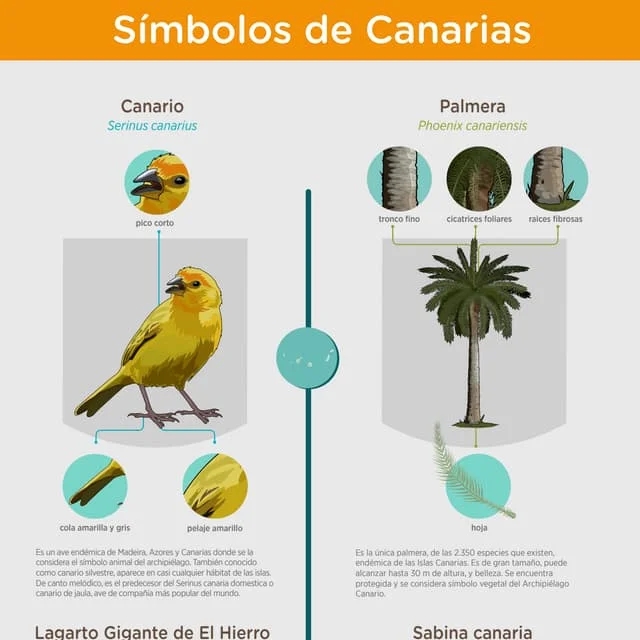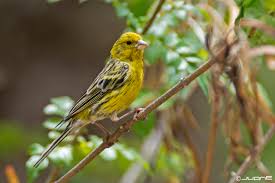I’m going to narrate a recent anecdote. In English.
On a famous Facebook humor page I came across a joke that said: Did you know that there is not a single canary bird in the Canary Islands? The same thing happens in the Virgin Islands: there are none.
Obviously, as a Spaniard, that felt like a slap in the face and I proceeded to correct the poster (who was also the administrator), and told him that this was nonsense as a joke: the birds known as canaries are, in fact, a species native to the Canary Islands.
The wild canary or canary serin (Serinus canaria) is a species of passerine bird of the finch family (Fringillidae). Despite its common and scientific name, it is native to several sub-archipelagos of Macaronesia: the Canary Islands, Azores and Madeira.
De Juana, E; Del Hoyo, J; Fernández-Cruz, M; Ferrer, X; Sáez-Royuela, R; Sargatal, J (2010).
I myself have been able to take photos of the birds and even nests when I visited the laurisilva jungle of La Gomera. What’s more, they are a symbol of the islands.
The canary is considered, according to the law of the Government of the Canary Islands, the natural symbol of the Canary archipelago, along with the Canary Islands palm tree.
Law 7/1991, of April 30, on symbols of Nature for the Canary Islands.

The two natural symbols of the Canary Islands archipelago: the canary (Serinus canaria) and the Canary palm tree (Phoenix canariensis).
The administrator became furious for having pointed out the falsehood and replied that «the name of the islands comes from the dogs, the canes» and that, in any case, «it was a joke».
And what I found is:
1. That many English-speaking people used to believe that the name of the Canary Islands came from the canary birds;
2. and upon learning that the name of the islands comes from a breed of giant dogs (canes) in Gran Canaria mentioned in classical texts (Pliny the Elder);
3. In their misinformed minds, the notion that the name of the islands came from «dogs», automatically made the existence of canary birds on the islands a myth… BECAUSE THEY HAD USED TO BELIEVE THAT THE NAME OF THE ISLANDS CAME FROM THE CANARY BIRDS.
The one next to it is Canaria; it contains vast multitudes of dogs of very large size, two of which were brought home to Juba
Pliny the Elder, Natural History (English). Chapter 37. The Fortunate islands.

On the left, regional flag and heraldic shield of the Canary Islands. In the center, the heraldic shield where you can see the dogs that give their name to the islands and on the right, an adult male specimen of the Canarian Presa dog with cropped ears. The Presa Canario is a descendant of the dogs bred by the native Guanches. It’s a breed of large dog of mastiff or catch dog type. It was formerly known as the Dogo Canario (some authors say they are different breeds) and it was traditionally used as a guard dog, as a herding dog for both sheep and cattle, for dog fighting and even in war. It’s one of the races used by Conquistadors in America and Spanish sailors to fight against Muslim pirates. In 1991 the dog was included in an official list of national symbols of the Canary Islands as a symbol of the island of Gran Canaria.
The authentic order is as follows: the dogs gave their name to the islands… and the islands LATER gave it to those birds.
I repeat. It is a myth or error that many English-speaking people believe and that has its origin in the fact that as they previously believed that the name of the islands came from birds, upon learning that the name comes from dogs (canes), they made a spurious association in their heads, starting to believe that it was a myth that there were canary birds in the Canary Islands.
And now there are tons of people who believe that canaries are not a natives species in the Canary islands and/or that there are no canaries in the Canary Islands.
The afore mentioned administrator got angry and blocked me.
Several things:
1. Humor can NEVER be an excuse to spread false information.
2. Be a perfectionist. Include caveats or footnotes to clarify confusion. Let’s fight fake news, hoaxes, false beliefs, etc. Let’s do good: let’s spread culture.
3. Let’s be more «Eastern» and less «Western» in that regard: if you have been proven beyond doubt that you are wrong, you lower your ears, acknowledge your mistake and correct yourself. This won’t kill you. Nobody is born knowing everything.
4. Don’t get angry with whoever corrects you. It is not fair, and even less so if it has been done politely and with a clear informative and demystifying intention. Apart from social issues and psychological maturity, it is a biological characteristic, I know, to not admit that the belief one had is false because it causes neurological tension (cognitive dissonance), perception of one’s own weakness, concession of power to the other, etc. But we are in the 21st century, we are no longer apes from the African savanna guided only by emotions and heuristics: you correct yourself, and that’s it.
5. And yes, they will call us perfectionists, nerds or fault-finders. Fighting disinformation wherever it is found is not only our civic obligation but part of our freedom of speech right. Because otherwise, misinformation expands, it can become more dangerous in the most unexpected ways (remember: we are talking about an endangered species in the wild). And this fight is even more of a duty, if the spreading lie is related to the scientific world… or our culture. No, I am not going to allow lies about one of our symbols.
6. Memes and jokes are NOT a substitute for formal education or the dissemination of knowledge, for that matter. That’s not how you learn about reality and here is the physical proof.

Photography: Canary (Serinus canaria) in the wild in Los Realejos, Tenerife island. 2009. Author Jörg Hempel.


Debe estar conectado para enviar un comentario.